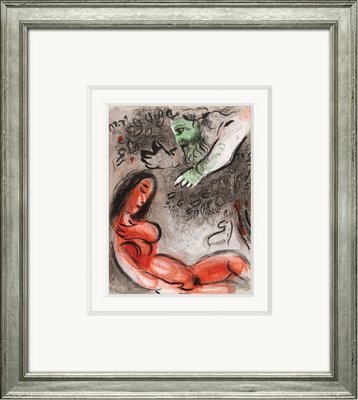
“When Matisse dies, Chagall will be the only painter left who understands what colour really is.” -Pablo Picasso
At age 53, Marc Chagall was at the peak of his career—and fleeing for his life.
It was December 1940 and the Jewish artist was awaiting passage out of France to New York, where the Museum of Modern Art was exhibiting his work. It was his ticket out of the Nazi-controlled country, an invitation that museum director Alfred H. Barr had strategically timed to spring the artist from Hitler’s rule before it was too late.
With his visa secured and a plan in place, Chagall was nearly free. Until authorities arrested him and a group of French Jews in April 1941 in France. They were then bound for deportation back to Germany.
But Varian Fry, the courageous director of the Emergency Rescue Committee in France, intervened and secured Chagall and his wife, Bella, two spots on a boat to Manhattan. Gallerist Pierre Matisse—the youngest child of Henri Matisse, who was to become Chagall’s United States art dealer, met them at the dock on June 21. A few months later, the Chagalls’ daughter, Ida, arrived with her husband and a trove of her father’s paintings—marked by bursts of color, soaring couples, the landscape of his Russian homeland and his Jewish heritage.
Not among them was his “Bible Suite,” a series of 12 lithographs commissioned in 1930 by Paris art dealer Vollard. The lithos illustrated key religious stories, including those of Adam and Eve, Cain and Abel, Sarah and Abimelech, and David and Michal.
The colorful works—featuring vibrant reds, oranges, yellows and blues—were reminiscent of a happier time, though the project was interrupted by the war and remained unfinished for decades. Finally, in 1956, French lithography studio Mourlot Frères printed the first set after Chagall completed the series. Today, the originals are believed to be in the hands of private collectors, but one of the etchings from the series is currently for sale on eBay for nearly $2 million.
The first lithos were met with such acclaim that another batch was published in 1960, followed by a limited edition of 500 prints, produced within the decade, that were scaled down by a third—24 of which English Country Antiques owners Chris Mead and Zoe Hoare now have hanging in their Bridgehampton store. The exhibit is being hung in conjunction with The Jewish Museum’s exhibition, “Chagall: Love, War, and Exile,” in Manhattan featuring 31 paintings and 22 works on paper. They explore a significant but neglected period in the artist’s career: the rise of fascism in the 1930s through '40s, his years spent in Paris and then his exile to New York.
“It’s vastly different, but still really great use of color,” Ms. Hoare said last week of the Chagall show in Manhattan, which she and Mr. Mead visited earlier this month. “The blues and the reds are so, so, so powerful. But it was a very scary time. The war is the reason there was a gap in this series.”
She gestured to the wall in front of her at her Bridgehampton store, hung with eight of the 12 Chagall prints—now framed in silver leaf that are being sold $2,600 each—that Mr. Mead purchased from a London dealer during one of his triannual trips. The collection included two of each print, which are 10½ inches wide by 14 inches tall, Ms. Hoare explained, as well as Henri Matisse linocuts and Pablo Picasso lithographs.
“Now, who doesn’t want to have a Picasso or a Chagall or a Matisse on their wall for under $3,000?” she said of the litho prints. “Because the real one would be in the millions. So, it’s not bad.”
Even though this particular set of prints was produced five decades ago, they are still relevant among current color and interior design trends, Ms. Hoare said. “The Face of Israel,” “Adam and Eve are Banished,” and “Cain and Abel” all use red, orange and rust tones, which are very trendy at the moment, she said, pulling at her crimson-patterned shirt. And, due to their modest sizes, the prints could be arranged as an installation instead of hanging individually, she said.
“For many of the larger homes out here—big wall space, lots of light—these would work very well in a living room because they’re important,” Ms. Hoare said. “He’s a well-known artist, so they need somewhere important to go, like a dining room or your main living room. And a big space. A lot of designers are using collections of artwork, where the collection becomes a piece of artwork in itself. It’s nice to be able to access some of the greatest artists for under $100,000. And Chagall was one of them.”
Unlike during his years in Paris, Chagall was never completely comfortable living in Manhattan, according to information provided by The Jewish Museum. He felt disconnected from the places he called home—Russia and France—a feeling that was compounded by the sudden death of his wife in 1944.
After his wife’s death, Chagall’s daughter hired him a housekeeper, Virginia Haggard McNeil, and a relationship soon formed. His work from this time expresses a tension between the memory of his late wife and his new romance, resulting in emotionally charged compositions, according to the museum.
In 1946, Chagall moved with Ms. McNeil to a house in High Falls, New York, before buying a home in Orgeval, outside of Paris, in 1948. A year later, they moved to Vence, France, where he died on March 28, 1985.
Gradually, as Chagall had emerged from his sadness, so had his artistry. The horrors of the war had receded. The pain of his wife’s death had faded. And by the time he died, his work had returned to a more familiar style: that of a happier Chagall. Canvases replete with childhood memories, levitating couples in love and, as always, his intense colors.